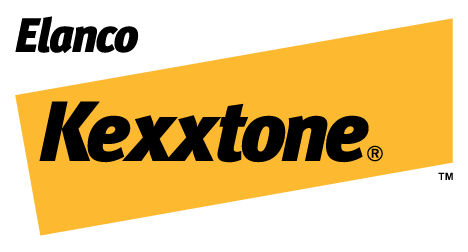Kexxtone®

Kexxtone®
Kexxtone® is a controlled release formulation of monensin (as monensin sodium) contained in a plastic capsule equipped with retaining wings. Slowly releasing monensin from the opening at its end, the capsule will remain effective for an average of 95 days after administration in lactating dairy cattle.
Key Features
- Continual release bolus containing monensin, providing on average 95 days of coverage
- Reduced the incidence of subclinical ketosis by 50% and the incidence of clinical ketosis by 40% in Canadian studies.1, 4
- Reduced the odds of positive fecal culture by 73% in cows found to be shedding Mycobacterium avium paratuberculosis (MAP) on day 0 (at the time of bolus administration).3
- Zero day withdrawal period for both meat and milk
Packs available
Kexxtone is available in a box of 40 boluses.
What is Kexxtone?
Kexxtone is approved as an aid in the prevention of ketosis and subclinical ketosis (hyperketonemia) in lactating dairy cattle. Herds may also see a reduction in the incidence of displaced abomasum in conjunction with reduced incidence of clinical or subclinical ketosis. It also is approved for the reduction in fecal shedding of Mycobacterium avium paratuberculosis (MAP) in mature dairy cattle in high risk Johne’s disease herds as an aid in the herd control of Johne’s disease as one component of a multi-component Johne’s disease control program. Please speak to your herd veterinarian for additional considerations for a Johne’s disease control program. In additional safety studies, dairy cows given Kexxtone showed no adverse effects when fed Rumensin® premix up to a dose of 16 ppm. Kexxtone is a continual release ruminal bolus containing monensin; it causes a shift in rumen microbial populations, favouring the production of propionic acid. Propionic acid is a precursor for glucose, which increases available energy and decreases levels of ketosis. The bolus of Kexxtone has been shown in Canadian studies to reduce the incidence of post-partum hyperketonemia by 50%.1
Rumensin® for production.
Kexxtone™ for health.
Both for your bottom line.
On average, an investment in Kexxtone for a typical Canadian herd can net a benefit of $70 per bolus2. Adding Rumensin to the milking ration at 16 ppm can net a benefit of $55.‡
Rumensin Premix offers improved feed efficiency of milk protein production while Kexxtone aids in preventing subclinical ketosis. The active ingredient in both products is the ionophore monensin sodium, which is used exclusively in cattle, small ruminants and poultry in Canada. This molecule has been extensively researched and has been approved in Canada for use in cattle for over 30 years.
Rumensin® For Production
Adding Rumensin Premix to rations for lactating dairy cows for the full lactation increases milk production per kilogram of feed, giving producers more milk from the same amount of feed or the same milk yield from less feed.

Improves the feed efficiency of milk protein production

Minimizes loss of body condition

Aids in the prevention of coccidiosis*

Increases rate of weight gain in growing cattle on pasture of greater than 180 kg (400 lb) body weight
*Coccidiocidal agents, like ionophores, kill coccidia found in the large and small intestines, where coccidiostatic agents simply slow the infection.
Kexxtone For Health
Kexxtone is recommended for use in herds in which health improvement is of interest, i.e. those at risk of ketosis (clinical or subclinical). Kexxtone remains in the rumen, continuously delivering the active ingredient for an average of 95 days.
Aids in the prevention of ketosis and subclinical ketosis in lactating dairy cattle1,4, which can result in a reduced incidence of displaced abomasum4.
Reduces the shedding of Mycobacterium avium paratuberculosis, the causative agent of Johne’s disease3.
The label contains complete use information, including cautions and warnings. Always read, understand and follow the label and use directions.
Dosage: Kexxtone delivers an approximate average dose of 335 mg of monensin per day for approximately 95 days. For indications 1 and 2, administer one capsule orally 2 to 4 weeks prior to expected calving date, using the Kexxtone administration tool.
NOTE: An animal safety study showed no adverse effects in dairy cows when monensin controlled release capsules were used in herds feeding Rumensin® Premix up to a dose of 16 ppm monensin activity.
Administration: Care should be exercised when administering Kexxtone to ensure the delivery to the correct location in the pharynx. Be sure that the head of the administration tool is past the base of the tongue. The correct administration tool position will be indicated by the animal beginning to swallow. Failure to do so may result in soft tissue damage or regurgitation.
Adequate animal restraint is required to properly administer this capsule. A headgate or chute used to restrain the animal must limit forward/backward motion and allow the animal’s head to be held in the forward extended position and without pressure on the neck (to prevent choking).

